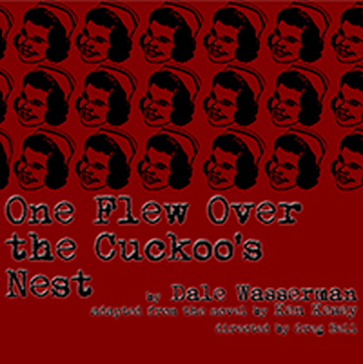The more insane a man is, the more powerful he becomes. To experience the ultimate theatrical power in action join the Psychoceramics— humanity’s crackpots— at The Audrey Herman Spotlighters Theatre for their production of Dale Wasserman’s One Flew Over the Cuckoo’s Nest. Directed by Greg Bell, this gripping off-kilter psycho drama, adapted from the novel by Ken Kesey, delves deep into the human psyche and confronts the inner pollutions of the minds of society’s outcasts: the insane. An ambitious and practically flawless production graces the theatre-in-the-square making the best use of the stage’s setup for its elaborate and gorgeous setting; the most stunning in many a year. A gift to lunacy and the craft of acting, Bell’s production is maddening to the point of ecstatic delight. A perfect cast with a real handle on dramatic tension, this show is a cathartic exploration of psychological drama that draws you in to the bitter end.
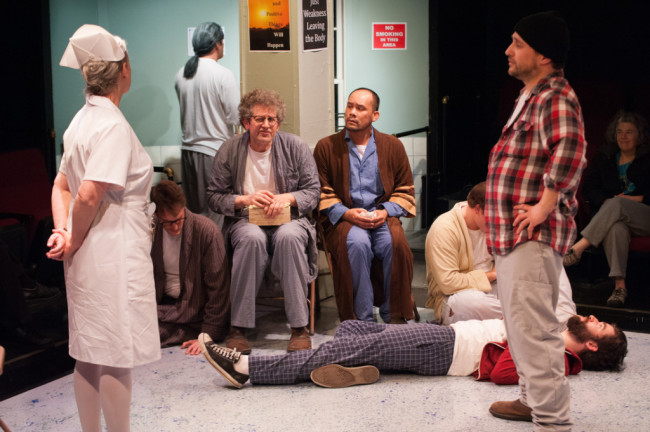
Resident Scenic Designer Alan Zemla has truly outdone himself by converting the space into a functioning State Mental Hospital. A total transformation engages a fully functioning barred window with the potential for escape, as well as a boxed in authentic looking nurse’s station. Zemla brings the sterile feeling of a mental facility into the whiteness of the columns and walls and augments this notion tenfold with little motivational posters and printed reminders of the facilities rules. Zemla creates atmospheric ambiance that is unsettling in its accuracy; creating a sense of isolation, claustrophobia, and nauseating numbness with his use of spatial analysis. Right down to the marbling of the institutionalized floor, Zemla’s attention and commitment to detail is stunning.
Costume Designer Amy Bell completes the asylum aesthetic with her crisp white orderly costumes. Stiff and bright their harsh blandness creates an antiseptic couture for the aides and nurses of the facility. Bell creates striking contrast from this pristinely kept order among the costumes arranged for the mental patients. Comfy pajama pants and careworn robes assist with the functionality of ambulatory shuffling about as well as peculiar behavior which further sets apart the patients from the caretakers.
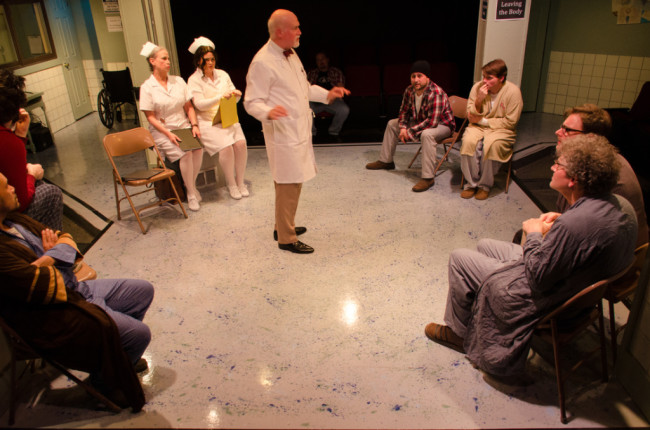
Using the nurse’s station as it’s designed, Nurse Ratched’s voice echoes over an intercom with hints of tinny grain to the echo, compliments of Sound Designer Heiko P. Spieker II. Blending the recorded voiceovers of Chief Bromden against an unsettling golden glow, crafted by Lighting Designer Fuzz Roark, each of the Chief’s memories becomes more than just a recurrent flashback. Spieker and Roark team up again later in the production to produce the jarring and disquieting Electro-Shock effect with great, creating an aesthetic that is, to say the least, shocking.
Director Greg Bell really finds the rhythm of this production, not moving too fast not moving too slow. Pacing— be it in one extreme or the other— can kill a show’s overall enjoyment factor and Bell’s ability to balance the more droll moments against those of heightened excitement is impeccable. Bell’s seasoned directorial hand guides background characters through ensemble scenes so that their presence is felt soundly without pulling focus from principle characters in their more crucial moments.
The ensemble of inmates inside the asylum is what makes the performance so fascinating. The intricate behavioral expressions are thoroughly articulated both physically and emotionally. Total character commitment is displayed consistently across the panel of minor players in this performance. Noteworthy inmate performances come particularly from two sources— Lou Otero and Frederick Frey. While neither performer spends as much time on stage as the principle patients, both Otero and Frey take the audience’s attention with force when they do appear. Otero’s wheelchair rocking and Frey’s crucifixion pose leave imprints on the mind that are not easily shaken, even after the performance has concluded.
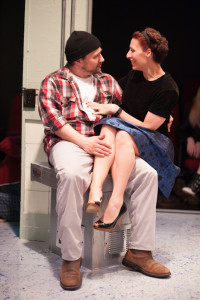
Amy Bell and Parker Bailey Steven could not be more opposite in regards to their character portrayals in the performance. As two of the three leading ladies, Bell and Steven nail the intricacies of their characters respectively. Steven, as the dowdy and timid nursing assistant to Nurse Ratched, is meager in her very essence. Cowering in the shadow of the head nurse, her perfectly timed fearful responses to the various patient outbursts inspire pity for the character. Bell, on the other hand, evokes a much more riveting response from the audience as a tarty and wayward woman. At ease with her sensuality and savvy cunning mannerisms, Bell fits the bill for the role of Candy Starr.
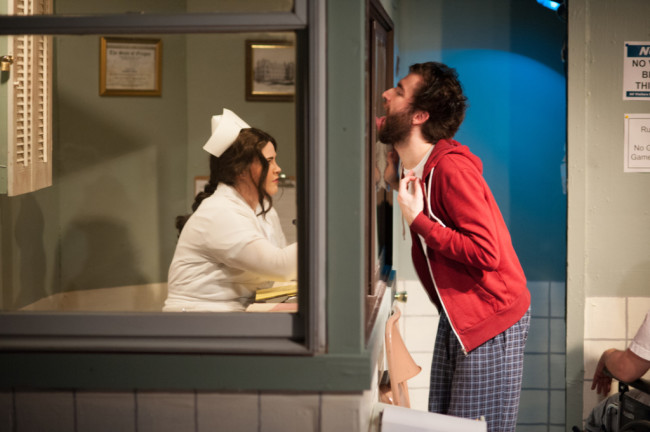
Playing the jittery Anthony Martini, Jim Baxter stands out as a promising scene stealer. Baxter’s portrayal of the twitchy mental patient is sublime; dedication to the extreme in his moments of continual nervous energy. Anxiety is more than apparent in his physical manifestation of the character and it is a brilliant recognition of the character’s internal struggles. Whether he is dashing madly across the stage in a frantic bout of chaos or teetering back and forth in place gazing off lost into space, Baxter creates a convincing persona that replicates the lost souls of the mentally ill as is appropriate for the era of the play’s setting.
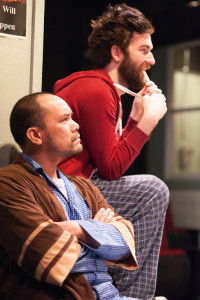
Scanlon, Cheswick, Bibbitt, and Harding (played by David Chalmers, Brian Kraszewski, Michael McGoogan, and Jose Reyes Teneza respectively) are the core quartet of the asylum’s crackpot makeup. Each with distinctive personality traits and a wholehearted commitment to making their character unique from just the average inmate, this quartet of performers seals the show in place with their work. Teneza’s overzealous flamboyancy really calls the character’s mental issues into question while McGoogan’s pitiable stuttering tugs at the empathetic heartstrings of the audience, particularly when he breaks down near the end of the performance.
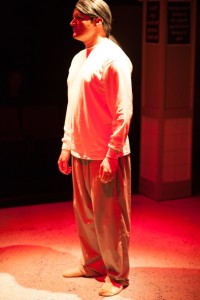
Chief Bromden (Nathan Parry) is a pillar of silent strength. At first completely silent, saved for the voiceover of Parry narrating his character’s internal monologues, the character appears listless. The perfect mimicry of a catatonic patient, Parry is methodical in his repetition, never faltering his blank stare or rigid physicality. Churning deep beneath the isolated exterior is a rich internal conflict that is expressed mutely through facial expressions near the play’s harrowing conclusion. With an impressive ability to maintain present and focused while simultaneously appearing far away, Parry invigorates the character with a desperate compassion often dismissed in near-silent characters.
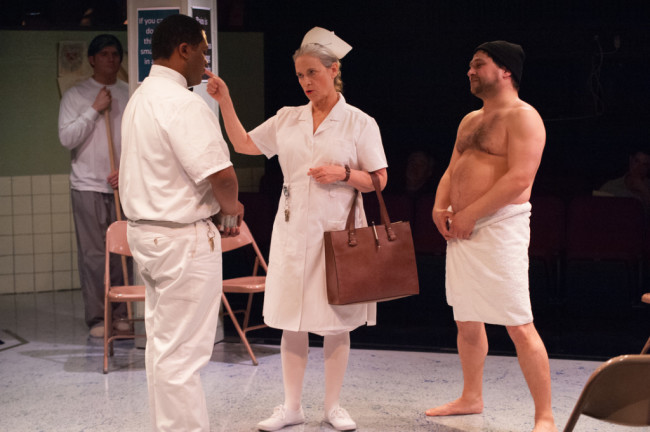
A true madcap maddog, Randle P. McMurphy (Rob Oppel) shakes things up with his arrival to the facility. Oppel delivers the performance of 2015; convivial, earnest, and downright crass with a sassy edge of honest down-home grit. Rolling in with guns blazing, Oppel expounds a great deal of his character’s energy verbally. With the true spirit of revolution coursing through him, Oppel finds ways to push the envelope every chance he gets, making McMurphy the perfect pain in Nurse Ratched’s backside.
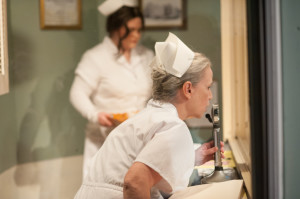
The formidable Nurse Ratched (Suzanne Young) inspires a plight of terror in her reign over the asylum. Young follows the rules of the character to the letter delivering a spectacular performance. Her cool, calculated presence atop her stoic and biting articulation make for a ruthless and unflappable portrayal of the iconic nurse from hell. Deliberate with every step, Young never flinches, even in the face of Oppel’s obnoxious antics. Her unyielding personality is as crisp as her uniform and sends the most uncomfortable of shivers up the spine just by entering a room. Delivering the stuff of nightmares, Young takes the character of Nurse Ratched to terrifyingly drastic new heights.
The therapeutic possibilities are endless when it comes to the theatre. Take your mind off your own troubles and sit a while at the asylum inside of Spotlighters Theatre, you might just find that what you’ve got going on inside your own head isn’t all that different from what’s happening inside their pristinely kept white walls.
Running Time: Approximately 2 hours and 30 minutes with one intermission
One Flew Over the Cuckoo’s Nest plays through April 19, 2015 at The Audrey Herman Spotlighters Theatre— 817 N. Saint Paul Street, in Baltimore, MD. For tickets call the box office at (410) 752-1225, or purchase them online.

